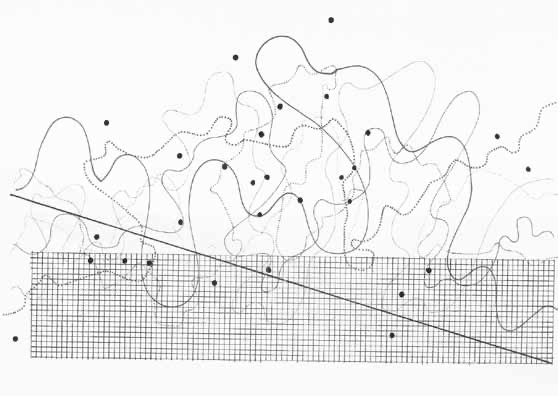2003

Max Neuhaus – Fontana Mix - Feed 1965-68: Six Realizations of John Cage Alga Marghen 2003 (plana-P 18NMN.044)
John Cage once recounted how, on attending a concert and intrigued by the high levels of amplified sound, he situated himself as close as possible to the loudspeakers in the hall. After a week of high-pitched tones ringing in his ears as a result, he eventually sought medical advice and was castigated by a physician for almost permanently damaging his ears. This anecdote clearly illustrates Cage’s propensity and fascination for the physicality of sound in all its dimensions, and paying attention – sometimes almost perilously – to what might be described as a phenomenology of sonic activity. From this perspective the listener must open him or herself up to the various parameters of sounds, their timbre, intensity, amplitude, etc., realizing a process, whereby, as Barthes once suggested, “listening is externalised, it compels the subject to renounce his inwardness.” Ideally, in Cage’s compositional world it is this process of externalisation that is shared by composer, performer and listener alike – the sounds existing in an abstract interface that traverses and yet deflects their individual subjectivities. This is the domain of indeterminacy and Cage’s particular works that are, as he described them, “Indeterminate with respect to their performance”, remain the cornerstone of a challenging and sometimes problematic performance practice. It is hardly surprising then that Cage’s radical indeterminate works from the later 1950’s including the Variations 1, Concert for Piano and Orchestra, and the piece featured on the present disc, Fontana Mix are not for the faint-hearted, and require immense investment on the part of the performer for any convincing performance to be realized. This release on the Italian Alga Marghen label of six realizations of Fontana Mix from 1965-68, by the (then) percussion virtuoso Max Neuhaus is a welcome addition to the catalogue, not just as a valuable document of his performances of Cage but also representing an important transitional phase in Neuhaus’s development as an artist. What he presents here is a distinctive realization of the score ‘patented’, if you like, by the addition of Feed to the title of the piece, and pointing directly to the nature of the sound source utilised by the performer.
What Cage provides in Fontana Mix is a set of transparent sheets consisting of points, curves, a graph chart and a straight line. From these materials the performer must construct the various parameters of the performance and deduce a time frame of actions and manipulations according to how the transparent points, curves and lines intersect with each other. Depending on the remit and frames that the performers set themselves, the resulting performances of this piece are practically infinite in their potential variety. As the appended title suggests, Neuhaus’s interpretation of the score focuses solely on feedback, the score being used to map adjustments in amplification and the interaction of four channels. Such techniques had been developed around 1963 from his experiments with amplifying sounds from his battery of percussion instruments, and the recordings available here are the results of Neuhaus’s extensive concert tours as a solo percussionist. By the time of these performances Neuhaus had perfected the technique of laying contact microphones on the percussion instruments giving the feedback more timbral grain (the microphones remained loose on the instruments so that movement can take place during performance resulting in slightly changing directional alignments of microphone to microphone, microphone to speaker, etc.). In each of the six realizations (four live recitals, two studio recordings) the results are remarkably rich morphologies of sound. Drones, even chords, and sounds reminiscent of orchestral bursts, electric saws, low-flying aircraft or helicopters drift in and out of the highly complex sound world. At times we hear the granular crackling reminiscent and prophetic of the sounds favoured by the current batch of lap-top improvisers. Because of the changing conditions and configuration of microphones to percussion and speakers, the fixed control score determined by Neuhaus from Cage’s original generated extremely unpredictable aural results in terms of overall shape and resulting interaction of timbres for each performance. They result in a fascinating concentration on the changeability of sounds’ gradual emergence, dying away and synchronicity. It was not long after these recordings that Neuhaus turned his back on performing altogether; firstly through ‘lecture demonstrations’ simply entitled Listen, and later exploring sound installations of specifically constructed timbres relating to place. Both of these later developments reflect Neuhaus’s rejection of the constraints and formalities of the concert hall and the inevitable restrictions these bring to bear on working directly with sound as an almost sculptural entity. In performers, Cage admired and perhaps demanded a sense of ‘urgency’ – a combination of scientific enquiry and a complete overhaul of their technical and aesthetic ‘knowledge’ with each performance. David Tudor exemplified this attitude, and we can certainly sense this spirit in Max Neuhaus’s performances. It is, after all, with this same sense of urgency that he made the transition from musician to sound artist, himself coining the now ubiquitous term ‘sound installation.’ These recordings – rare documents of Neuhaus the performer - have long been unavailable, and now, with the remastering sounding very good indeed (together with one track published for the first time), it is a must for those interested in noise-based music.
David Ryan